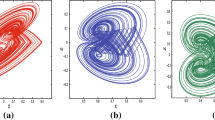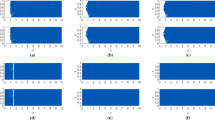Abstract
This paper introduces the hardware implementation of Digital Pseudo-Random Number Generators (DPRNG) based on chaotic systems. First, high-performance pipeline hardware architectures, respectively, for the 3D Lorenz, 3D Chua, 3D Rossler, and 3D Chen chaotic systems are designed to increase the operating frequency. The study also includes an examination of the hardware architectures with 32-bit fixed-point and 32-bit single floating-point data precision. Second, hardware architectures of DPRNG based on a single chaotic system and the congruential generator are put forward. Third, a robust DPRNG, that mixes the 3D Lorenz, 3D Chua, 3D Rossler, and 3D Chen chaotic systems is proposed where all designed chaotic systems operate in parallel. This architecture increases pseudo-random numbers space up to 2480. The FPGA implementation of the proposed pipeline hardware architecture of the complex DPRNG can achieve a maximal operating frequency of 192.446 MHz with a high throughput of 73,899.264 Mbps. The NIST 800-22 test suite result indicates that the DPRNG produces high-quality pseudo-random bits. Consequently, the proposed DPRNG is deemed suitable for use in high-speed applications.













Similar content being viewed by others
Data Availability
The data used to support the findings of this study are included within the article.
References
Gafsi, M., et al.: FPGA hardware acceleration of an improved chaos-based cryptosystem for real-time image encryption and decryption. J. Amb. Intell. Human Comput. 14, 7001–7022 (2023). https://doi.org/10.1007/s12652-021-03555-5
Martínez-Fuentes, O., et al.: Family of controllers for predefined-time synchronization of Lorenz-type systems and the Raspberry Pi-based implementation. Chaos, Solitons Fractals 179, 114462 (2024). https://doi.org/10.1016/j.chaos.2024.114462
Hafsa, A., Gafsi, M., Machhout, M.: ‘A lightweight and robust block cipher algorithm for real-time applications. Signal, Image Video Process. (2023). https://doi.org/10.1007/s11760-023-02831-5
Gafsi, M., et al.: Hardware implementation of a strong pseudorandom number generator based block-cipher system for color image encryption and decryption. Int. J. Circ. Theor. Appl. 51(1), 410–436 (2023). https://doi.org/10.1002/cta.3415,10.1002/cta.3415
Hafsa, A., Fradi, M., Sghaier, A., et al.: Real-time video security system using chaos- improved advanced encryption standard (IAES). Multimed. Tools Appl. 81, 2275–2298 (2022). https://doi.org/10.1007/s11042-021-11668-4
Gafsi, M., Amdouni, R., Hajjaji, M.A., Malek, J., Mtibaa, A.: Improved chaos-RSA-based hybrid cryptosystem for image encryption and authentication. Concurr. Computat. Pract. Exper. 34(23), e7187 (2022). https://doi.org/10.1002/cpe.7187.10.1002/cpe.7187
Yu, F., et al.: Design and FPGA implementation of a pseudorandom number generator based on a four-wing memristive hyperchaotic system and Bernoulli map. IEEE Access 7, 181884–181898 (2019). https://doi.org/10.1109/ACCESS.2019.2956573
Ahmed A. Rezk et al.: Multiplier less chaotic Pseudo random number generators. J. Electron. Commun. 113, 239–251 (2020). https://doi.org/10.1016/j.aeue.2019.152947.
Shah, D.K., et al.: FPGA implementation of fractional-order chaotic systems. Int. J. Electron. Commun. 78, 245–257 (2017). https://doi.org/10.1016/j.aeue.2017.05.005
Zhang, L. et al.: System generator model-based FPGA design optimization and hardware co-simulation for Lorenz chaotic generator. In: 2017 2nd Asia-Pacific Conference on Intelligent Robot Systems (ACIRS), Wuhan, China, 2017, pp. 170–174. https://doi.org/10.1109/ACIRS.2017.7986087.
Tuna, M., et al.: A novel secure chaos-based pseudo random number generator based on ANN-based chaotic and ring oscillator: design and its FPGA implementation. Analog Integr. Circ. Sig. Process. 105, 167–181 (2020). https://doi.org/10.1007/s10470-020-01703-z
Luis Gerardo de la Fraga et al.: Hardware implementation of pseudo-random number generators based on chaotic maps. Nonlinear Dyn. 90, 1661–1670, (2017). https://doi.org/10.1007/s11071-017-3755-z.
Samuel Souza da Silva et al.: A new chaos-based PRNG hardware architecture using the HUB fixed-point format. IEEE Trans. Instrument. Meas. 72, 1–8, 2023, Art no. 2001208. https://doi.org/10.1109/TIM.2023.3235457 (2023).
Abderrahim, N.W et al.: FPGA Implementation of a Chaotic Pseudo-random Numbers Generator. SN COMPUT. SCI, Volume 4, article number 410. https://doi.org/10.1007/s42979-023-01837-7 (2023).
Trujillo-Toledo, D.A.: Real-time RGB image encryption for IoT applications using enhanced sequences from chaotic maps. Chaos, Solitons Fractal, 153 (Part 2), 111506 (2021). https://doi.org/10.1016/j.chaos.2021.111506
Abbassi, N., et al.: Hardware implementation of a robust image cryptosystem using reversible cellular-automata rules and 3-D chaotic systems. Integration 87, 49–66 (2022). https://doi.org/10.1016/j.vlsi.2022.06.007
Senouci, A. et al.: FPGA based hardware and device-independent implementation of chaotic generators. Int. J. Electron. Commun. 82, 211–220 (2017). https://doi.org/10.1016/j.aeue.2017.08.011
Schmitz, J., Zhang, L.: Rössler-based chaotic communication system implemented on FPGA. In: 2017 IEEE 30th Canadian Conference on Electrical and Computer Engineering (CCECE), Windsor, ON, 2017, pp. 1–4. https://doi.org/10.1109/CCECE.2017.7946729.
Rukhin, A. et al.: A statistical test suite for random and pseudorandom number generators for gryptographic applications. Special Publication 800–22 Revision 1a, National Institute of Standards and Technology (NIST), April 2010.
Yu, F., Liu, L., Shen, H., Zhang, Z., Huang, Y., Cai, S., Deng, Z., Wan, Q.: Multistability analysis, coexisting multiple attractors, and FPGA implementation of Yu–Wang Four-Wing Chaotic System. Math. Prob. Eng. 2020, Article ID 7530976, 16 pages (2020). https://doi.org/10.1155/2020/7530976
Valencia-Ponce, M.A., González-Zapata, A.M., de la Fraga, L.G., Sanchez-Lopez, C., Tlelo-Cuautle, E.: Integrated circuit design of fractional-order chaotic systems optimized by metaheuristics. Electronics 12(2), 413 (2023). https://doi.org/10.3390/electronics12020413
Valencia-Ponce, M.A., Castañeda-Aviña, P.R., Tlelo-Cuautle, E., Carbajal-Gómez, V.H., González-Díaz, V.R., Sandoval-Ibarra, Y., Nuñez-Perez, J.-C.: CMOS OTA-based filters for designing fractional-order chaotic oscillators. Fractal Fract. 5, 122 (2021). https://doi.org/10.3390/fractalfract5030122
Author information
Authors and Affiliations
Contributions
All the authors helped to conceive these simulation experiments. Mohamed Gafsi and Amal Hafsa designed and performed the experiments and have written the main part of the manuscript. Mohamed Gafsi, Amal Hafsa and Mohsen Machhout contributed to the interpretation of the results.
Corresponding author
Ethics declarations
Conflict of interests
The authors declare no conflicts of interest.
Additional information
Publisher's Note
Springer Nature remains neutral with regard to jurisdictional claims in published maps and institutional affiliations.
Rights and permissions
Springer Nature or its licensor (e.g. a society or other partner) holds exclusive rights to this article under a publishing agreement with the author(s) or other rightsholder(s); author self-archiving of the accepted manuscript version of this article is solely governed by the terms of such publishing agreement and applicable law.
About this article
Cite this article
Gafsi, M., Hafsa, A. & machout, M. Hardware implementation of digital pseudo-random number generators for real-time applications. SIViP (2024). https://doi.org/10.1007/s11760-024-03082-8
Received:
Revised:
Accepted:
Published:
DOI: https://doi.org/10.1007/s11760-024-03082-8




